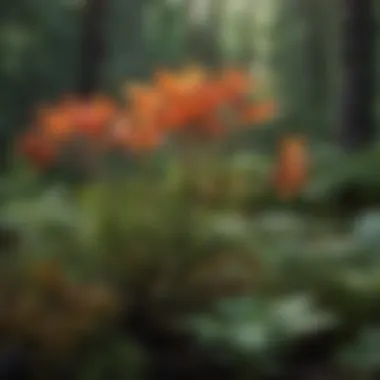Colorado Native Plant Society Gardening Guide


Intro
Gardening with native plants offers an opportunity to engage with Colorado's unique ecosystem while contributing to environmental sustainability. This guide aims to equip gardeners with the necessary knowledge to cultivate indigenous flora effectively. By understanding the ecosystem's intricacies, gardeners can make informed choices that benefit both their gardens and the wider environment.
The importance of native plants extends beyond mere aesthetics. They play a crucial role in supporting local wildlife, maintaining soil health, and promoting biodiversity. By providing food and habitat for various species, gardeners can effectively contribute to the ecological balance. Likewise, native plants are typically more resilient and require less maintenance compared to exotic species, making them an ideal choice for many gardeners.
This article will outline several key topics related to native plants in Colorado, including:
- Identification and selection of suitable species
- Practical planting techniques
- Maintenance and care for sustainable growth
- Environmental considerations and stewardship practices
- Benefits to local ecosystems and biodiversity
Equipped with this knowledge, gardeners can make conscientious decisions that lead to flourishing landscapes while supporting Colorado's native ecosystems.
Preface to Native Gardening in Colorado
Native gardening in Colorado offers unique advantages for both the environment and those who choose to cultivate local flora. Working with native plants supports biodiversity, encourages sustainable practices, and fosters a connection with the local ecosystem. Understanding these dimensions is crucial for any gardener interested in adopting native gardening practices.
Defining Native Plants
Native plants are species that have occurred naturally in a given region without human introduction. In Colorado, native plants are adapted to the specific climate and soil conditions of the area, making them suited for local gardening. These plants have evolved over thousands of years and play critical roles in their native habitats. They provide food and shelter for various wildlife, contribute to soil health, and help maintain local ecological balance.
Some well-known native plants in Colorado include:
- Rocky Mountain Bee Plant (Peritoma serrulata)
- Black-eyed Susan (Rudbeckia hirta)
- Colorado Blue Columbine (Aquilegia coerulea)
These species not only thrive in local conditions but also require less water and maintenance than many non-native plants.
Significance of Native Plants in Colorado's Ecology
The ecological significance of native plants in Colorado cannot be overstated. They form the backbone of Colorado's ecosystem, supporting various animal species and maintaining the regions' ecological processes. Native plants help stabilize soil and prevent erosion. They also improve water retention in the soil, which is crucial in areas that experience seasonal droughts.
Furthermore, native plants are key in attracting pollinators like bees, butterflies, and hummingbirds. These creatures play an essential role in plant reproduction and, thus, biodiversity. The decline of native plant species often leads to a decline in pollinator populations, illustrating the interconnectedness of native flora and fauna.
"Native plants are not just ornaments but fundamental components of a healthy ecosystem. They create the foundation for a thriving local environment."
In summary, native plants are not only important for gardening aesthetics but are essential for sustaining Colorado's biodiversity and ecological integrity. Engaging in native gardening aligns personal gardening goals with the larger aim of promoting environmental health.
Understanding Colorado's Climate and Soil
Understanding the climate and soil of Colorado is crucial for successful native gardening. This section focuses on the unique characteristics of Colorado's environment that influence which native plants thrive and how they should be nurtured. The state boasts diverse climate zones and varied soil types, both of which play a significant role in plant selection and garden management. By grasping these elements, gardeners can make informed decisions, ensuring their efforts contribute to a sustainable and thriving native plant ecosystem.
Climate Zones in Colorado
Colorado has several climate zones, ranging from arid high desert in the east to humid mountain environments in the west. The state's distinct climate features include:
- Temperature Variations: Colorado experiences significant temperature swings, both daily and seasonally. Average highs can vary by several degrees in different zones.
- Precipitation Patterns: The eastern plains receive less precipitation compared to the western foothills and mountainous areas. Understanding how much rain your specific area gets annually is essential for choosing drought-tolerant species.
- Sun Exposure: Elevations play a role in sunlight availability. Higher altitudes typically receive more intense UV radiation, affecting the growth patterns of plants.
Gardeners should study local climate information to determine which native species are best suited for their area. This approach ensures that plants will flourish under specific weather conditions.
Soil Composition and Fertility
Soil in Colorado varies greatly, making it important to evaluate your local soil composition and fertility before planting. Key factors to consider include:
- Soil Types: The state has sandy, clay, and loamy soils. Each type has different water retention abilities. For example, sandy soils drain quickly but may not hold moisture well.
- Nutrient Levels: Testing soil for nutrients, such as nitrogen, phosphorus, and potassium, can identify what amendments may be needed. Native plants often thrive in less fertile soils, but they still require certain nutrients for optimal growth.
- pH Levels: Assessing soil pH helps determine the suitability for selected species. Native plants often prefer a slightly acidic to neutral pH.
Gardeners can improve soil conditions through techniques such as composting or mulching, which enhances fertility and improves moisture retention. This preparation is fundamental to creating a thriving garden that aligns with the ecological framework of Colorado’s natural habitats.
"Understanding the local climate and soil is essential for cultivating a successful indigenous plant garden in Colorado."
In summary, recognizing the climate zones and soil composition in Colorado is not just beneficial; it is essential for fostering a successful native plant garden. This knowledge empowers gardeners to select appropriate species, implement effective gardening practices, and contribute positively to Colorado’s ecological health.
Selecting Native Plants for Your Garden
Selecting native plants for your garden is crucial for several reasons. Native plants are well-adapted to the local environment, making them more resilient to pests and diseases. They also require less maintenance once established, which can save time and resources. Furthermore, these plants play a vital role in local ecosystems. They provide food and habitat for wildlife, including pollinators and birds, creating a more biodiverse environment. Therefore, understanding how to select the right native plants is integral to the success of your garden.
Identifying Local Ecosystems
Understanding your local ecosystem is the first step in selecting the right native plants. Colorado features diverse ecosystems, ranging from alpine tundra to ponderosa pine forests. Each ecosystem has unique conditions such as soil type, moisture levels, and light exposure. By identifying which ecosystem your garden falls into, you can better choose plants that will thrive in those specific conditions. Resources like the Colorado Native Plant Society can help you determine local ecosystems and their characteristics.
Choosing the Right Species
Selecting the appropriate species involves considering multiple factors, including the specific growing conditions and the ecological roles of different plant types.
Herbaceous Perennials


Herbaceous perennials are important for adding color and texture to the garden. These plants endure seasonal dieback, only to return stronger in subsequent years. A notable characteristic of herbaceous perennials is their wide variety of heights and bloom times. They can attract pollinators, enhancing the ecological health of your garden. However, it's crucial to choose species that naturally occur in your local area to avoid introducing aggressive non-natives.
Shrubs
Shrubs play a crucial role in providing structure and habitat in a native garden. They often serve as shelter for birds and small mammals, which contributes to local biodiversity. A key characteristic of native shrubs is their ability to tolerate local climate conditions, whether that's drought or heavy snowfall. Additionally, shrubs require less water once established. However, some shrubs can be invasive if not properly managed, so it's important to research and choose wisely.
Trees
Trees are foundational elements in any native landscape, offering shade, beauty, and habitat. Native trees are adapted to local soil and climatic conditions, which helps reduce resource needs over time. Their large size and canopy structure create microhabitats for various species. A key advantage of planting native trees is their long-term benefits to the ecosystem, including carbon sequestration and soil stabilization. However, it is essential to consider the space available and the mature size of the trees when planting them.
Site Preparation for Native Plant Gardening
Preparing the site for native plant gardening is essential for success. This phase lays the groundwork for healthy growth and sustainability. Taking the time to assess your space and amend the soil will ensure that your native plants thrive in their new environment.
Assessing Your Garden Space
Assessing your garden space involves understanding its topography, sunlight exposure, and existing vegetation. Not all spots in your yard will be equally suitable for native plants. Therefore, observe the patterns of light and shade throughout the day. Areas that receive at least six hours of sunlight daily are often best for many native species.
Examine the existing soil conditions. This means digging a small hole to check soil texture and structure. If the soil is compacted or hard, it might not provide the necessary aeration for roots to grow.
Understanding any drainage issues is also important. Identify areas where water tends to pool, which could lead to root rot in some plants. Lastly, consider any unwanted invasive species nearby. It is important to know your competition and address it before planting your natives.
Soil Amendment Techniques
Soil amendment is a critical step that can influence plant vigor. Native plants often adapted to the local ecosystem benefit from thoughtful soil practices. First, test your soil's pH and nutrient levels. Most native plants prefer a pH between 6.0 and 7.0.
Adding organic material is one way to improve soil quality. Compost or well-aged manure can enhance fertility and improve soil structure. This encourages beneficial microbial activity. You can also integrate mulch into your gardening practice. This will help retain moisture and regulate soil temperature.
"Amending soil is not merely about fertility but about creating a microenvironment for plant roots."
Ongoing soil management must always be considered. Periodic testing and amendment can be beneficial as plants grow. It is wise to observe plants for signs of nutrient deficiency or excess.
In summary, site preparation is the cornerstone of successful native plant gardening. Assessing your space and amending your soil means you will set yourself up for a thriving garden that supports local flora and fauna.
Planting Techniques for Native Species
Planting techniques serve as a foundational aspect of successful native species gardening. Employing the right methods ensures that native plants not only survive but thrive in their designated environments. Proper planting techniques can significantly alter the outcomes for gardeners. These techniques also influence the ecological balance and overall health of the garden, making them crucial for anyone interested in native plant gardening.
Timing Your Planting
Timing plays a vital role in the success of planting native species. Gardeners must consider local climate patterns and seasonal changes to determine the most advantageous time to plant. For instance, many native plants benefit from being planted in the spring or fall, when temperatures are moderate and rainfall is generally more reliable. This ensures roots can establish before the season's extreme conditions.
- Spring Planting: Ideal for most perennial native plants. Soil temperatures are warming up, encouraging growth.
- Fall Planting: Good for allowing roots to establish before the winter freeze, making for robust growth in the spring.
Additionally, understanding your specific microclimates can help optimize planting times. Monitoring local weather forecasts and soil moisture will guide you in determining the right moment for planting, thus enhancing survival rates and growth vigor.
Transplanting Methods
Transplanting native plants requires careful consideration to ensure they adjust well to new environments. The following methods outline best practices for successful transplantation:
- Bare-Root Transplanting: This method is preferable for many native plants; roots are removed from the soil during dormancy in winter or early spring. Be sure to keep roots moist during the process.
- Container Planting: Use native plants grown in containers for more flexibility. Make certain to select suitable-sized pots when transplanting. Pre-soaking the root ball before planting can reduce transplant shock.
- Spacing Considerations: Ensure adequate spacing between transplanted specimens to allow for mature growth without overcrowding. This is significant for both aesthetics and health of the plants.
Proper aftercare for transplanted species is also necessary. Gradual acclimatization to sunlight and regulated watering can help plants adapt to their new setting. Following these transplanting methods will encourage a healthy native plant garden, contributing to the greater ecological landscape.
"Adopting correct planting techniques can facilitate not just individual plant health, but also the stability of local ecosystems."
By prioritizing timing and effective transplanting methods, gardeners can cultivate a landscape that genuinely supports and enhances the native flora of Colorado.
Maintaining a Healthy Native Plant Garden
Maintaining a healthy native plant garden is essential for supporting biodiversity and enhancing Colorado's unique ecosystems. Native plants are adapted to local conditions, which means they often require less maintenance than non-native varieties. This section provides insights into essential practices like watering and pest management, allowing gardeners to cultivate thriving landscapes that resist disease and promote ecological balance.
Watering Practices
Watering is one of the most basic yet critical elements in maintaining a native plant garden. Understanding how much water your native plants need is key to fostering their growth and resilience. Many native plants are drought-resistant, having adapted to the local climate. Still, during the establishment phase, they need adequate watering to develop strong roots.
Here are some practices to consider:
- Deep Root Watering: Water plants deeply but infrequently. This encourages roots to grow deeper, making plants more resilient to drought.
- Morning Watering: Watering in the morning allows plants to absorb moisture before the heat of the day promotes evaporation.
- Mulching: Applying mulch helps retain soil moisture and reduces the need for frequent watering. Organic mulch, like wood chips or straw, not only conserves moisture but also adds nutrients to the soil.
Proper watering techniques lead to healthier plants that can thrive without excess input, crucial to a sustainable gardening practice.
Weed and Pest Management


Weed and pest management is another crucial aspect of maintaining a healthy native plant garden. Weeds compete for nutrients, water, and sunlight. Effective strategies should be in place to minimize their impact. Likewise, managing pests without chemicals supports a balanced ecosystem.
Here are some methods to implement:
- Regular Monitoring: Check your garden regularly for weed growth and pest activity. Early detection allows for quicker and less invasive responses.
- Hand Weeding: Remove weeds by hand to prevent their spread. This is particularly effective in smaller gardens.
- Natural Predators: Encourage beneficial insects, such as ladybugs and lacewings, that help keep pest populations in check.
- Companion Planting: Certain native plants can attract pests away from your main crops or deter harmful insects altogether.
Maintaining a healthy native plant garden requires consistent effort and strategic practices. By focusing on proper watering techniques and effective weed and pest management, gardeners can create environments where native flora thrives and biodiversity flourishes.
Creating Habitat for Wildlife
Creating habitats that support wildlife is an essential aspect of native gardening. It mirrors the ecological balance occurring in natural settings, thus enhancing the resilience of the local ecosystem. Native plants offer critical food sources, nesting sites, and shelter for various wildlife species. By cultivating these plants in your garden, you not only contribute to biodiversity but also forge a stronger connection with nature.
Attracting Pollinators
Pollinators are vital to the reproduction of many plants, including agricultural crops. Bees, butterflies, and other insects play a crucial role in our ecosystem. To attract these essential creatures to your garden, consider planting native flowers that bloom at different times throughout the growing season.
- Choose Diverse Species: Selecting a variety of plants ensures blooming occurs over a longer period. This approach provides a steady food source for pollinators. Native flowers like Echinacea purpurea and Asclepias tuberosa are excellent for this purpose.
- Create Shelter: Pollinators need safe spaces to rest and breed. Leaving areas of your garden unmowed or adding structures like bee hotels can offer essential habitats.
- Avoid Pesticides: Chemical pesticides can be harmful to pollinators. Emphasize organic methods for pest management to create a more inviting environment.
By implementing these strategies, one can substantially increase the presence of pollinators within the garden, thereby enriching the local biodiversity.
Supporting Local Fauna
Beyond pollinators, supporting a wide range of local fauna is important for a vibrant native plant garden. Birds, small mammals, and even reptiles all play roles in the ecological system. Here are some guidelines on how to support local wildlife effectively:
- Food Sources: Incorporate fruit-bearing shrubs like Amelanchier alnifolia. These plants provide berries that are essential for birds and other wildlife throughout the seasons.
- Nest and Rest Areas: Dense plantings can offer cover for small mammals and breeding sites for birds. Trees such as Quercus gambelii not only support local avian species but also provide spaces for others to shelter from predators.
- Water Access: A small birdbath or pond can attract various species. Make sure the water is easily accessible and refreshed often to support wildlife needs.
In summary, diversifying the habitat for local fauna by selecting appropriate native species, providing shelter, and ensuring food and water availability fosters a diverse and healthy ecosystem in your garden.
"Healthy ecosystems are resilient and create balance in nature. Gardening with native species actively contributes to this balance."
By focusing on these elements, gardeners can create vibrant habitats that not only enhance their landscape but also support the local wildlife and contribute to ecological health.
Sustainable Practices in Native Gardening
Sustainable gardening practices are essential in cultivating native plants. They not only promote environmental health but also ensure that the gardening efforts are viable long-term. This segment focuses on how adopted practices can benefit ecosystems, minimize waste, and promote biodiversity. By integrating sustainable methods, gardeners support a healthier environment while enjoying the natural beauty of indigenous species.
Organic Gardening Techniques
Using organic gardening techniques is crucial for maintaining soil health and supporting the local ecosystem. Organic gardening reduces reliance on synthetic fertilizers and pesticides. This creates a safer habitat for beneficial insects and soil organisms.
- Composting: Incorporating compost into your garden enriches the soil. It provides essential nutrients for plants without harmful chemicals. Composting reduces waste by recycling kitchen scraps and yard waste.
- Natural Pest Control: Instead of using chemical pesticides, consider natural remedies. Companion planting can keep pests away, while beneficial insects like ladybugs can help control populations of harmful pests.
- Soil Improvement: Use natural methods to improve soil structure. Techniques like crop rotation and cover crops help maintain soil fertility and structure.
Minimizing Resource Use
Minimizing resource use in native plant gardening involves smart choices that reduce environmental impact. Efficient use of water, energy, and materials is key.
- Water Conservation: Employ techniques like drip irrigation to minimize water usage. Also, consider xeriscaping, which is designing the landscape to require little or no irrigation.
- Native Plant Selection: Choosing native plants that are adapted to the local climate leads to lower maintenance. These plants tend to require less water and are more resilient to local pests and diseases.
- Eco-friendly Materials: Opt for biodegradable and renewable materials in your gardening projects. This includes wooden stakes, biodegradable pots, and sustainable mulch alternatives.
Embracing sustainable practices in native gardening not only enhances the landscape but also contributes to a balanced ecosystem.
By implementing these sustainable methodologies, gardeners can ensure that their practices support local ecology while promoting healthy gardening habits.
Challenges in Native Plant Gardening
Gardening with native plants in Colorado presents unique opportunities and challenges. One of the key elements to focus on is recognizing that even though native plants are well-suited for the local environment, they are not immune to certain issues that can hinder their growth and sustainability. This knowledge not only aids gardeners in making informed decisions but also fosters a deeper connection with the evolving landscape of their gardens.
Common Pests and Diseases
In any garden, pests and diseases can be a significant challenge. Native plants are not inherently pest-free. However, their adaptations often make them more resilient compared to non-natives. Understanding the common pests and diseases can help in maintaining a healthy native plant garden. Some insects like the grasshopper and various beetles may cause damage.
For diseases, consider issues like powdery mildew or root rot, especially in wet conditions.
Effective management includes observational skills and preventive measures:
- Regular inspections: Look for unusual changes in leaf color or growth patterns.
- Healthy soil practices: Ensure your soil is well-draining and rich in organic matter.
- Companion planting: Certain native plants can deter pests, such as marigolds, which can guard more vulnerable species.
Culturally appropriate management practices are essential. Emphasizing biodiversity by planting a variety of species can also mitigate the risk of pest outbreaks. Encouraging natural predators, such as ladybugs for aphids, supports a balanced ecosystem in your garden.
Adapting to Climate Change
Climate change poses ongoing challenges for gardeners, especially in a place like Colorado where environmental conditions are variable and often extreme. This impact can include altered rainfall patterns, temperature shifts, and increased occurrences of drought or pests.
One important consideration is to recognize how these changes affect local plant species. Native plants may demonstrate resilience, yet their adaptability does not guarantee survival in shifting climates. Strategies to adapt include:


- Choosing resilient species: Opt for plants that are known to withstand varying conditions, such as Asclepias tuberosa (Butterfly Weed) that can thrive in drought.
- Modified watering practices: Implementing rainwater collection systems or drip irrigation can support plants during dry spells.
- Monitoring weather trends: Keep track of local weather patterns to prepare for shifts in your plant care regimen.
"Adapting gardening practices to climate change is not just an act of preservation; it is a commitment to ensuring the future of biodiversity in Colorado's ecosystems."
Collectively, these factors underscore the necessity for ongoing education and awareness. Engaging in community discussions and local environmental programs can offer insights and practical solutions to these pressing challenges.
By addressing both pests and climate variability proactively, gardeners cultivate not only a diverse landscape but also a resilient ecological habitat for future generations.
Resources for Colorado Native Plant Gardening
Gardening with native plants in Colorado is not just about aesthetic appeal; it encompasses a profound commitment to preserving the ecological integrity of the region. By utilizing available resources, gardeners can make informed choices that enhance biodiversity and promote sustainability. This section highlights essential resources that guide individuals in their quest to cultivate indigenous flora, with a focus on the benefits they provide.
Colorado Native Plant Society
The Colorado Native Plant Society (CNPS) stands as a pivotal organization for anyone interested in native plant gardening. Its mission includes conservation and promotion of Colorado's native plants through education, research, and community initiatives. Members benefit from access to a wealth of knowledge, which includes local plant lists, gardening workshops, and events tailored to both novice and experienced gardeners.
The society offers a plethora of resources:
- Affiliation with Experts: Being part of CNPS connects gardeners with botanists and horticulturists who can provide crucial insights on plant selection and maintenance.
- Educational Materials: Guides and manuals provide information on proper gardening techniques, suitable species for various ecosystems, and ways to enhance wildlife habitats.
- Networking Opportunities: Gardeners can share experiences, challenges, and success stories, fostering a community dedicated to native gardening.
Through its community outreach and educational efforts, the CNPS serves as an invaluable ally in navigating the challenges of native plant gardening in Colorado.
"Understanding the local ecosystem is key to thriving native gardens and preserving biodiversity."
Local Nurseries and Seed Sources
Local nurseries and seed sources play an integral role in the native plant gardening landscape. These establishments not only provide native species but often ensure their stock is suited for Colorado's specific climate and soil conditions. Choosing the right plants is essential for successful gardening. Here are some factors to consider:
- Variety of Species: Reputable nurseries will offer a diverse selection of native plants, from herbaceous perennials to shrubs and trees, catering to various garden designs and habitats.
- Expert Advice: Nursery staff can provide valuable information on the plants they sell, including care requirements and compatibility with local wildlife. This guidance aids gardeners in making informed decisions.
- Local Adaptation: Plants sourced locally are often better adapted to cope with regional pests and diseases, enhancing their chances of survivability.
Some noteworthy local nurseries and seed sources include:
- High Country Gardens: Known for its extensive selection of native plants suitable for dry climates.
- Native Roots: Specializes in native seeds that promote biodiversity.
- Denver Botanic Gardens Plant Sale: Offers a range of native plants and educational resources during seasonal sales.
Utilizing these resources strengthens the garden's ecosystem and supports local economies, making a lasting impact that benefits both the environment and the community.
The End: The Importance of Native Gardening
Native gardening holds significant relevance, particularly within Colorado's unique ecosystem. It offers substantial advantages that contribute to environmental health and sustainability. Understanding these benefits is essential for all stakeholders involved in ecological preservation and urban landscape design.
Benefits to the Environment
Native plants are intrinsically designed to thrive in their local environments. They require fewer resources, such as water, fertilizers, and pesticides, resulting in lower maintenance costs for gardeners and helping to conserve local resources. Here are a few critical environmental benefits:
- Biodiversity: Native plants support a wide range of species, including pollinators, birds, and beneficial insects, fostering a rich network of life.
- Erosion Control: The deep root systems of many native species help stabilize soil, reducing erosion and runoff, which is particularly crucial in areas susceptible to landslides or flooding.
- Water Conservation: By planting species adapted to Colorado's climate, gardens can minimize water usage, a pressing concern in drought-prone areas.
"Incorporating native plants into gardening practices is one of the most effective strategies for promoting local ecosystems."
This extensive reliance on native flora contributes significantly to the resilience of ecosystems, making them more adaptable to changing climate conditions and environmental pressures.
Encouraging Community Involvement
The movement towards native gardening encourages community engagement and education. When individuals come together to promote sustainable landscaping, they create a shared sense of responsibility toward their environment. Here are a few ways in which community involvement can be encouraged:
- Workshops and Seminars: Hosting events focusing on the principles of native gardening can empower individuals and families to take actionable steps toward ecological responsibility.
- Demonstration Gardens: Establishing community gardens that showcase native plant species can serve as living examples for others to replicate in their private spaces.
- Collaborative Projects: Engaging schools and local businesses in native gardening initiatives can strengthen community ties while beautifying public and private spaces alike.
Frequently Asked Questions
In any practical guide, especially one focused on gardening, the section on Frequently Asked Questions serves a critical function. It allows readers to address their immediate concerns and expands their understanding of the subject matter. This article tackles complex topics like native plant gardening with the aim of demystifying the process.
Addressing frequently asked questions not only enhances clarity but also promotes reader engagement. Providing answers to common queries offers a pathway for individuals to embark on their gardening journey with confidence. Moreover, these questions can highlight specific features of native plants, encouraging gardeners to explore biodiversity more deeply.
How do start my native plant garden?
Starting a native plant garden can be an enriching experience. Begin by assessing your available space. Consider factors like sunlight exposure, soil type, and water availability. Once you understand your environment, explore local ecosystems. Native plants thrive in conditions similar to their natural habitats.
A practical step is to select a few native species suited for your area. Research local nurseries that specialize in indigenous plants. Consider consulting resources like the Colorado Native Plant Society for additional guidance. When preparing your garden, ensure a healthy soil composition. Avoid chemical fertilizers; instead, utilize organic amendments to enhance soil health.
Once you are ready for planting, follow all recommendations for spacing and depth of each species. Regular maintenance is necessary, including watering practices aligned with the needs of native plants. This process forms the foundation for a successful native plant garden.
What are the best native plants for drought resistance?
When selecting drought-resistant native plants, focus on species that have adapted to Colorado's challenging climate. Plants such as the Blue Grama Grass, Rabbitbrush, and Yucca are excellent choices for dry conditions. These species exhibit traits like deep root systems, which help to access moisture below the surface.
Here are some other suitable drought-resistant plants:
- Prairie Coneflower (Ratibida columnifera)
- Sagebrush (Artemisia tridentata)
- Indian Ricegrass (Achnatherum hymenoides)
In addition, incorporating mulch around your plants can significantly reduce water evaporation. It will also suppress weeds, which compete for water resources. Choose drought-resistant native plants to create a low-maintenance, sustainable garden that thrives despite water scarcity.



